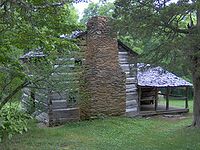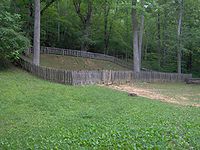
Little Greenbrier (Great Smoky Mountains)
Encyclopedia

Great Smoky Mountains
The Great Smoky Mountains are a mountain range rising along the Tennessee–North Carolina border in the southeastern United States. They are a subrange of the Appalachian Mountains, and form part of the Blue Ridge Physiographic Province. The range is sometimes called the Smoky Mountains or the...
of East Tennessee. The community was situated in a hollow rising from Metcalf Bottoms along Little River
Little River (Tennessee)
Little River is a scenic river in Tennessee which drains a area containing some of the most spectacular scenery in the southeastern United States. The first of the river are all located within the borders of the Great Smoky Mountains National Park...
to the upper slopes of Cove Mountain, in the northeastern section of the national park
Great Smoky Mountains National Park
Great Smoky Mountains National Park is a United States National Park and UNESCO World Heritage Site that straddles the ridgeline of the Great Smoky Mountains, part of the Blue Ridge Mountains, which are a division of the larger Appalachian Mountain chain. The border between Tennessee and North...
. Little Greenbrier was once known simply as "Greenbrier," but the "Little" was added to its name to distinguish it from the larger Greenbrier
Greenbrier (Great Smoky Mountains)
Greenbrier is a valley in the northern Great Smoky Mountains of Tennessee, located in the Southeastern United States. Now a recreational area, Greenbrier was once home to a string of Appalachian communities....
located between Mount Le Conte and Mount Guyot
Mount Guyot (Great Smoky Mountains)
Mount Guyot is a mountain in the eastern Great Smoky Mountains, located inthe southeastern United States. At above sea level, Guyot is the fourth-highestsummit in the eastern U.S., and the second-highest in the Great Smoky Mountains National Park...
to the east.
Little Greenbrier is currently home to the Walker Cabin and the
Little Greenbrier Schoolhouse— both on the National Register of Historic Places
National Register of Historic Places
The National Register of Historic Places is the United States government's official list of districts, sites, buildings, structures, and objects deemed worthy of preservation...
.
Geography
Little Greenbrier is located in a gradually-ascending hollow on the southwestern flank of Cove Mountain. This mountain links up with the eastern flank of Roundtop Mountain to form a long wall-like ridge that provides a natural boundary between Wears ValleyWears Valley, Tennessee
Wears Valley is an unincorporated area in Sevier County, Tennessee, treated by the U.S. Census Bureau as a census county division. As of the 2000 Census, the population of Wears Valley was 6,486....
and the national park (the park boundary roughly follows the ridgecrest). Little Brier Branch, its source near the top of Cove Mountain, flows southward and drains Little Greenbrier before emptying into Little River
Little River (Tennessee)
Little River is a scenic river in Tennessee which drains a area containing some of the most spectacular scenery in the southeastern United States. The first of the river are all located within the borders of the Great Smoky Mountains National Park...
at Metcalf Bottoms.
Lyon Springs Road, which connects Wears Valley Road (U.S. Route 321
U.S. Route 321
U.S. Route 321 is a spur of U.S. Route 21. It runs for 526 miles from South Carolina to Tennessee. The northern terminus of U.S. 321 is between Lenoir City and Oak Ridge, Tennessee, at Interstate 40 exit 364, which is about 4 miles west of Interstate 40's junction with Interstate 75...
) with Little River Road, passes near Little Greenbrier. A short gravel road leads from Lyon Springs Road to the Little Greenbrier Schoolhouse. The rest of Little Greenbrier can be reached via short hiking trails, namely the Little Brier Gap Trail from Metcalf Bottoms, or the much longer Cove Mountain Trail from the Sugarlands Visitor Center several miles to the east.
History
The earliest documented settlers in Little Greenbrier were Alexander McKenzie and Arthur "Brice" McFalls. McKenzie and McFalls, who had been neighbors in South CarolinaSouth Carolina
South Carolina is a state in the Deep South of the United States that borders Georgia to the south, North Carolina to the north, and the Atlantic Ocean to the east. Originally part of the Province of Carolina, the Province of South Carolina was one of the 13 colonies that declared independence...
, arrived in the 1830s. McFalls is believed to have built a cabin in the 1840s that was reassembled by later arrival John Walker as the "kitchen" half of the Walker Cabin.
Around the time of the Civil War, William and Riley Metcalf, two brothers of Cherokee
Cherokee
The Cherokee are a Native American people historically settled in the Southeastern United States . Linguistically, they are part of the Iroquoian language family...
descent, moved their families to the flats around the confluence of Little Brier Branch and Little River that now bears their name. During the construction of Little River Road in the 1920s, members of the Metcalf family supplied drinking water to road construction crews, and in appreciation the picnic area later established in the area by the National Park Service was named for the Metcalfs.
Little Greenbrier School
Built in 1882, the Little Greenbrier SchoolLittle Greenbrier School
The Little Greenbrier School is a former schoolhouse and church in the ghost town of Little Greenbrier in Sevier County, Tennessee, United States. Located near Gatlinburg in the Great Smoky Mountains National Park, it was built in 1882, and was used as a school and church almost continuously until...
functioned as the community school until 1936. Over its fifty-four year history, it was used as a schoolhouse under the supervision of nearly fifty teachers, and it was the house of worship for a Primitive Baptist
Primitive Baptist
Primitive Baptists, also known as Hard Shell Baptists or Anti-Mission Baptists, are conservative, Calvinist Baptists adhering to beliefs that formed out of the controversy among Baptists in the early 1800’s over the appropriateness of mission boards, bible tract societies, and temperance...
church. It is located at the center of what was once Little Greenbrier.
Walker Sisters Place

By 1921, the cabin and farm had passed to five of Walker's daughters— Margaret Jane, Polly, Louisa, Hettie, and Martha— who had lived on the land their entire lives. The National Park Service assumed control of the land when the last of the Walker Sisters died in 1964.
In the 1930s, the commission responsible for buying land for the Great Smoky Mountains National Park unsuccessfully attempted to persuade the Walker sisters to sell the homestead. Fearing bad publicity, the commission balked at forcing the Walkers out via condemnation suits. The Walker sisters finally sold the farm in 1941 in exchange for a lifetime lease. A local legend claims the sisters were paid a visit by President Franklin Roosevelt who convinced them to sell the land (Roosevelt was in the area to dedicate the national park in 1940, but there is no known record of a visit to the Walker place).
Greenbrier Cemetery


